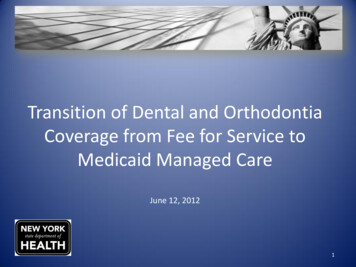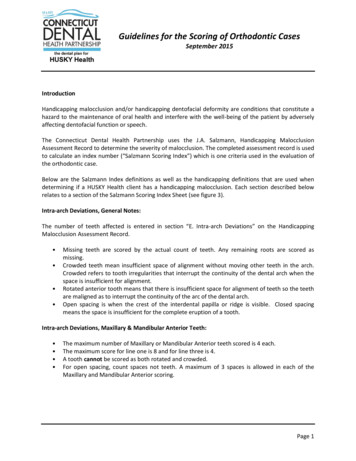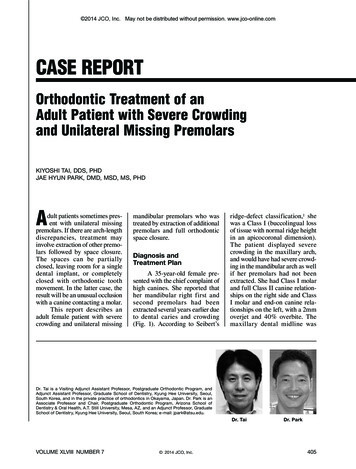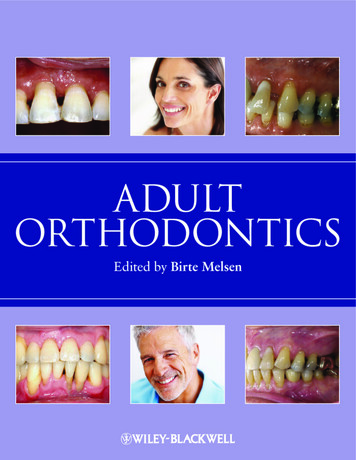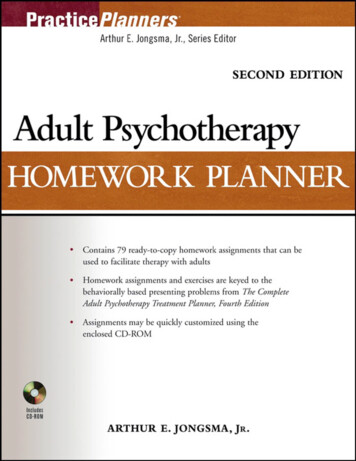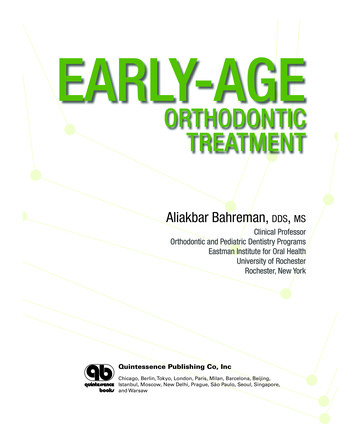
Transcription
EARLY-AGEORTHODONTICTREATMENTAliakbar Bahreman, DDS, MSClinical ProfessorOrthodontic and Pediatric Dentistry ProgramsEastman Institute for Oral HealthUniversity of RochesterRochester, New YorkQuintessence Publishing Co, IncChicago, Berlin, Tokyo, London, Paris, Milan, Barcelona, Beijing,Istanbul, Moscow, New Delhi, Prague, São Paulo, Seoul, Singapore,and WarsawBahreman FM.indd iii3/19/13 11:42 AM
ContentsForeword by J. Daniel Subtelny viiPreface and Acknowledgments viii–ixIntroduction xPart I1Rationale for Early-Age Orthodontic Treatment2Development of the Dentition and Dental Occlusion3Examination, Early Detection, and TreatmentPlanning 413Part IIEarly-Age Orthodontic Treatment of NonskeletalProblems 714Space Management in the Transitional Dentition5Management of Incisor Crowding6Management of Deleterious Oral Habits7Orthodontic Management of Hypodontia8Orthodontic Management of Supernumerary Teeth9Diagnosis and Management of Abnormal FrenumAttachments 20510Bahreman FM.indd vClinical and Biologic Principles of Early-AgeOrthodontic Treatment 11573105131157189Early Detection and Treatment of EruptionProblems 2253/19/13 11:42 AM
Part III Early-Age Orthodontic Treatment of DentoskeletalProblems 29111Management of Sagittal Problems(Class II and Class III Malocclusions)12Management of Transverse Problems(Posterior Crossbites) 35513Management of Vertical Problems(Open Bites and Deep Bites) 377IndexBahreman FM.indd vi2934173/19/13 11:42 AM
ForewordThis book is a compendium of significant and pertinent information related to early-age orthodontic treatment, a subject that seems to have evolved into one of considerablecontroversy, with as many orthodontists expressing a negative reaction as a positive reaction to its benefits. Dr Bahreman is a believer in early-age orthodontic treatment, and heexpresses some cogent arguments founded in years of experience in practice and teaching to back up his beliefs. Indeveloping his treatise, Dr Bahreman outlines the development of the occlusion and/or malocclusion from the embryonic stages, when the foundation of the jaws and therebythe position of the dentition is first established.Early-age orthodontics is not about the time it takes toorthodontically treat a problem; it is a story of growth, ofvariation in anatomy, and of muscle function and influences, a realization that it is the jaws that contain the teethand that where the jaws go, the teeth will have to go, andboth undergo varying influences as well as grow in varyingdirections. Early-age orthodontics necessitates recognitionof this process and aims to alter and redirect it whenever feasible and possible. Dr Bahreman has undertaken amonumental effort in directing efforts along this path. Anextensive exploration of the literature is an added bonus, asthe mechanical approaches are based on this literature. Infact, the extensive review of the literature and its application to diagnosis and varying forms of therapy are worth averitable fortune.You may or may not agree with the basic premises, butyou will have access to important information that will widen your scope of vision and thereby widen your treatmenthorizons. To my mind, an ounce of prevention, if possible, isworth a pound of cure. The reality of prevention can exist atthe earliest stages of development.J. Daniel Subtelny, DDS, MS, DDSc(Hon)Professor EmeritusInterim Chair and Director of Orthodontic ProgramEastman Institute for Oral HealthUniversity of RochesterRochester, New YorkviiBahreman FM.indd vii3/19/13 11:42 AM
PrefaceAfter obtaining a master’s degree in orthodontics in 1967, Ibegan my career at a newly founded dental school in Tehran.My responsibilities included teaching and administrative duties at the university and maintenance of a very busy privatepractice. In addition, I established both the orthodontic andpediatric dentistry departments at the university.Many patients were being referred to the orthodontic department, and there were no qualified faculty members tohelp me provide care. To rectify the situation, I designed anadvanced level, comprehensive curriculum in orthodonticsfor undergraduate students, including classroom instruction,laboratory research, and clinical demonstrations. Once thestudents completed the course, they could work in the clinic,thus temporarily solving the issue of the heavy patient loadin the orthodontic clinic. With additional staff now available, Icould select patients, mostly children in the primary or mixeddentition, for some interceptive treatment.Despite my difficulties in performing all of the aforementioned duties, this situation had a fortunate outcome. It helpedme to understand and discover the advantages of early-ageorthodontic treatment, which was not common in thoseyears. During my more than 40 years of practice and teaching,especially in early orthodontic treatment, I have accumulateda considerable amount of educational data for teaching purposes. I would like to share this experience and informationwith readers.The public’s growing awareness of and desire for dentalservices, especially at an early age, have encouraged our profession to treat children earlier. Despite the recommendationby the American Association of Orthodontists that orthodontic screening begin by the time a child is 7 years old, manyorthodontists still do not treat children prior to the completeeruption of the permanent teeth. I believe that this inconsistency is due to the educational background of orthodontistsas well as a lack of familiarity with recent technical advancements and the various treatment options that are available foryoung patients.The therapeutic devices available for this endeavor are notcomplex, but deciding which ones to use and when to employthem are important steps. As we make these decisions, weshould also remember not to treat the symptom but rather totreat the cause. My goal is to present the basic informationnecessary to understand the problems, to differentiate amongvarious conditions, and to review different treatment options.Case reports are examined to facilitate clinical application ofthe theory in a rational way.To understand the morphogenesis of nonskeletal and skeletal occlusal problems, to detect problems early, and to intervene properly, we must look at all areas of occlusal development, including prenatal, neonatal, and postnatal changes ofthe dentoskeletal system, and explore all genetic and environmental factors that can affect occlusion at different stagesof development. In other words, we must have a profoundunderstanding of the fundamental basis and morphogenesisof each problem and then apply this knowledge to clinicalpractice. Thus, the goals of this book are: To provide a comprehensive overview of all areas of dentaldevelopment, from tooth formation to permanent occlusion, to refresh the reader’s memory of the fundamentalsnecessary for diagnosis and treatment planning. To emphasize all the important points of the developmental stages that must be recognized during examination ofthe patient to facilitate differential diagnosis. Each tooth canbecome anomalous in a number of ways and to differentdegrees. Occlusion and maxillomandibular relationshipscan vary in the sagittal, transverse, and vertical directions. To discuss the application of basic knowledge to practice bypresenting several cases with different problems and different treatment options. To demonstrate the benefits of early-age orthodontic treatment, achieved by intervention in developing malocclusionand guidance of eruption.Materials are presented in three parts: In Part I, “Clinical andBiologic Principles of Early-Age Orthodontic Treatment,” threechapters introduce and explain the concept of early-age treatment, describe its necessity and advantages, and discuss thecontroversies surrounding this topic; discuss the basic foundation of occlusal development, empowering the practitionerto detect anomalies and intervene as necessary; and illustratethe procedures, tools, and techniques available for diagnosis,emphasizing differential diagnosis and treatment planning forearly-age treatment.Part II, “Early-Age Orthodontic Treatment of NonskeletalProblems,” consists of seven chapters describing the nonskeletal problems that might develop during the primary andmixed dentitions. The chapters explain the ontogeny, diagnosis, and early detection of, and intervention for, these problems. Topics include space management, crowding, abnormaloral habits, abnormal frenum attachment, hypodontia, supernumerary teeth, and abnormal eruption problems.viiiBahreman FM.indd viii3/19/13 11:42 AM
Part III, “Early-Age Orthodontic Treatment of DentoskeletalProblems,” consists of three chapters on early interventionfor the dentoskeletal problems that might arise during the primary and mixed dentitions in the three dimensions: sagittalproblems (anterior crossbite and Class II and Class III malocclusions); transverse problems (posterior crossbites); and vertical problems (open bites and deep bites).This book will provide the reader with a firm foundation ofthe basic science and case examples with various treatmentoptions. It is my hope that the information provided will promote a better understanding of abnormalities and their causesand enable readers to recognize the clues for early detectionand intervention.AcknowledgmentsTehran, whose dedication as an educator and preparationof superb histologic slides is remarkable and who allowedme to use his slides in my publication; Mr Aryan Salimi forscanning some of the slides and radiographs in this book;and Ms Elizabeth Kettle, Program Chair of the Dental Section of the Medical Library Association, head of Eastman’slibrary, for her sincere help in editing this publication.Finally, I wish to acknowledge the constant support ofmy family: Malahat, Nasreen, Saeid, Alireza, Tannaz, andPeymann Motevalei. Especially high gratitude goes to mywife, Malahat, for her tolerance, support, and encouragements. I also want to thank my son Alireza for his technicalhelp and guidance in computer skills and my granddaughterTannaz Motevalei for drawing some of the illustrations.This publication is the product of 17 years spent organizing materials derived from my 45 years of practice andteaching as well as reviewing hundreds of articles andbooks. I herewith dedicate this book to the teachers, practitioners, residents, and students who are dedicated to treating malocclusion earlier in children, before it becomes morecomplicated and costly.First and foremost, I would like to gratefully acknowledgethe valuable opportunity that was afforded me as a studentin Dr Daniel Subtelny’s orthodontic program. Between 1964and 1967, I completed both my orthodontic specialty andmaster degree programs with Dr Subtelny as my mentor. Aschairman and program director, researcher, and mentor, DrSubtelny has dedicated over 57 years of his life to teaching,personally influencing the lives of over 350 students fromaround the world, myself included. In 1999, after over 32years of teaching, practicing, and administrating in Tehran, Iwas fortunate enough to return to the Eastman Institute forOral Health to work alongside Dr Subtelny as a faculty member in the Orthodontic and Pediatric Dentistry Programs.In addition to Dr Subtelny, there are several individuals towhom I would like to express my deep gratitude for theirhelp and encouragement in preparation of this book: thelate Dr Estepan Alexanian, head of the Department of Histology at the Shahid Beheshti University Dental School inixBahreman FM.indd ix3/19/13 11:42 AM
IntroductionOcclusal development is a long process starting around thesixth week of intrauterine life and concluding around the ageof 20 years. This long developmental process is a sequenceof events that occur in an orderly and timely fashion underthe control of genetic and environmental factors. Dental occlusion is an integral part of craniofacial structure and coordination of skeletal growth changes. Occlusal development isessential for establishing a normal and harmonious arrangement of the occlusal system.As we learn about craniofacial growth changes, the potential influences of function on the developing dentition, andthe relationships of basal jawbones and head structure, weacquire a better understanding of when and how to intervene in the treatment guidance for each patient. It is moreeffective to intervene during the primary or mixed dentitionperiod to reduce or, in some instances, avoid the need formultibanded mechanotherapy at a later age.Untreated malocclusions can result in a variety of problems, including susceptibility to dental caries, periodontaldisease, bone loss, temporomandibular disorders, and undesirable craniofacial growth changes. Moreover, the child’sappearance may be harmed, which can be a social handicap.The benefits of improving a child’s appearance at an earlyage should not be undervalued. The goals of many clinicianswho provide early treatment are not only to reduce the timeand complexity of comprehensive fixed appliance therapybut also to eliminate or reduce the damage to the dentitionand supporting structures that can result from tooth irregularity at a later age. In short, early intervention of skeletal anddental malocclusions during the primary and mixed dentitionstages can enable the greatest possible control over growthchanges and occlusal development, improving the function,esthetics, and psychologic well-being of children.For many decades, orthodontists have debated about thebest age for children to start orthodontic treatment. While weagree on the results of high-quality orthodontic treatment,we often differ in our opinions as to how and when to treatthe patient. Some practitioners contend that starting treatment in the primary dentition is the most effective means oforthodontic care. Others prefer to begin the treatment in themixed dentition. There is also controversy about whether theearly, middle, or late mixed dentition is preferable.Despite the fact that the American Association of Orthodontists recommends that orthodontic screening be startedby the age of 7 years, many orthodontists do not treat children prior to the eruption of permanent teeth, and somepostpone the treatment until the full permanent dentitionhas erupted, at approximately 12 years. The controversy surrounding early versus late treatment is often confusing tothe dental community; therefore, clinicians must decide ona case-by-case basis when to provide orthodontic treatment.Indeed, there are occasions when delaying treatment until alater age may be advisable.The long-term benefits of early treatment are also controversial. The majority of debates seem to revolve aroundearly or late treatment of Class II malocclusions. There is lesscontroversy regarding many other services that can be performed for the benefit of young patients during the primaryor mixed dentition, such as treatment of anterior and posterior crossbite, habit control, elimination of crowding, spacemanagement, and management of eruption problems.Practitioners who are in favor of early treatment of Class IIproblems contend that early intervention is the best choicefor growth modification when the problem is skeletal andespecially when it results from mandibular retrusion. On theother hand, opponents believe that there is no difference inthe final result and that a single-phase treatment approach ispreferable because of the advantages that accompany thereduced treatment time.Unfortunately, some practitioners, without a profoundevaluation of the indications for early treatment, concludethat late treatment is always preferable. However, broadconclusions drawn from narrowly focused research can bemisleading. One cannot conclude that no birds can fly byconsidering the flight characteristics of the ostrich.To evaluate and demonstrate the benefits of early treatment, I aim to discuss and clarify available treatments andservices and discuss cases with different problems and different treatment options. An understanding of all aspects ofearly treatment requires a thorough knowledge of the basicsof embryology, physiology, and growth and development.This includes development of the dentition, tooth formation,eruption, exfoliation, and all transitional changes. Therefore,my other goal is to integrate the basic science and the clinical, in order to refresh the reader’s memory on importantpoints about the bases of nonskeletal and skeletal problemsthat can arise during the transitional stages of occlusion.Each patient who enters our practice represents a newchapter and a new lesson that we can learn from. A thoroughknowledge of the basis for early-age orthodontic treatment,an understanding of the proper treatment techniques, anda willingness to consider their appropriateness for each individual patient will allow us to intervene in ways that willprovide the maximum benefit for a young and growing child.xBahreman FM.indd x3/19/13 11:42 AM
PARTICLINICAL ANDBIOLOGIC PRINCIPLESOF EARLY-AGEORTHODONTICTREATMENTBahreman CH01.indd 13/18/13 10:26 AM
1Rationale for Early-AgeOrthodontic TreatmentIn the past, orthodontic treatment has been focused mainly on juvenile and adult treatment. Treatment options for patientsin these age groups often are limited by complex dental and orthodontic problems and the lack of sufficient future craniofacial growth.During the later part of the 18th century, orthodontic treatment of Class II malocclusion was limited primarily to retraction of the maxillary anterior teeth to decrease excessive overjet. In 1880, Norman Kingsley1 published a description oftechniques for addressing protrusion. He was among the first to use extraoral force to retract the maxillary anterior teethafter extraction of the maxillary first premolars; the extraoral force was applied with headgear. Later, Case2 continued torefine these methods.Angle’s classification3 of malocclusion, published in the 1890s, provided a simple definition of normal occlusion and wasan important step in the development of orthodontic treatment. Angle opposed the extraction of teeth and favored thepreservation of the full dentition. His position against tooth extraction led him to depend on extraoral force for the expansion of crowded dental arches and retraction of the anterior segment. Later he discontinued the use of extraoral force andadvocated the use of intraoral elastics to treat sagittal jaw discrepancies.Because of Angle’s dominating belief that treatment with Class II elastics was just as effective as extraoral force, the useof headgear was abandoned by the 1920s. Then, in 1936, Oppenheim4 reintroduced the concept of extraoral anchorage,employing extraoral traction to treat maxillary protrusion. Accepting the position of the mandible in Class II malocclusions,Oppenheim attempted to move the maxillary dentition distally by employing a combination of occipital anchorage andan E-arch, allowing the mandible to continue its growth. This resulted in an improved relationship with the opposing jaw.In 1947, Silas Kloehn5 reintroduced extraoral force, in the form of cervical headgear, for the treatment of skeletal Class IIrelationships.In 1944, another student of Angle’s, Charles Tweed,6 was discouraged by the prevalence of relapse in many of his patients treated without extraction, so he decided to oppose the conventional wisdom of nonextraction.In the early part of the 20th century, there was optimism about the influence of orthopedic force on skeletal growth. Analmost universal belief was that orthodontic forces, if applied to the growing face, could alter the morphologic outcome.In the United States, headgear was the principal appliance used for facial orthopedic treatment, whereas in Europe thefunctional appliance was predominantly used.In 1941, Alan Brodie,7 one of Angle’s students, concluded that the growing face could not be significantly altered fromits genetically predetermined form and that the only option for the orthodontist in cases of skeletal malocclusion would bedental camouflage, or the movement of teeth within their jaws. This idea led to tooth extraction.3Bahreman CH01.indd 33/18/13 10:26 AM
3Examination, Early Detection, and Treatment PlanningPanoramic radiographsThe panoramic radiograph is a common diagnostic tool intoday’s dental practice. It is a kind of radiograph that provides a full picture of the dentition and the complete maxillaand mandible.Panoramic radiographs do not show the fine detailcaptured on intraoral radiographs and are not as specificas other intraoral radiographs, but in a single radiograph itprovides a useful general view of all dentition, the maxillaand mandible, the sinuses, and both TMJs. This typeof radiograph is very useful, especially during the mixeddentition, for early detection and prevention of all problemsdisturbing the normal development of occlusion.Especially during the mixed dentition as a diagnostictool for early-age orthodontic treatment, the following areimportant aspects that should be carefully evaluated on apanoramic radiograph before any orthodontic treatment: Position and pattern of fully emerged as well as emergingpermanent teeth Sequence of permanent tooth eruption Asymmetric eruption Comparison of crown height levels on the left and rightsides Obstacles preventing eruption Abnormal tooth malformations (gemination, fusion, densin dente, or dilaceration) Exfoliation and pattern of primary teeth root resorption Tooth number and supernumerary teeth or congenitallymissing teeth Eruption problems, such as impaction, ectopic, transposition, or ankylosis Bone density and trabeculation Cysts, odontomas, tumors, and other bone defects orpathologic lesions Third and second molar positions, inclinations, and relationships to the first molars and ramus edge Shape of the condylar head and ramus height Comparison of the left and right condylar heads and ramiLongitudinal PanoramicRadiograph MonitoringOver many years of teaching and practice, in both pediatric dentistry and orthodontic departments, the author became interested in conducting a retrospective evaluationof patients who were referred for some type of orthodonticproblem and who had previous panoramic radiographs available. This retrospective evaluation led to the conclusion thatthe longitudinal monitoring of panoramic radiographs during the mixed dentition is a very valuable, easy techniquethat enables detection of developmental anomalies duringthe transitional dentition. Today the author strongly recommends this easy and very useful technique to all practitioners, especially pediatric dentists and orthodontists.The transitional dentition is one of the most critical stagesof the dentition, and many eruption problems, whetherhereditary or environmental, emerge during this stage.Longitudinal panoramic radiograph monitoring is a carefulserial monitoring technique that any practitioner can performfor young patients during transitional dentition to watch fordevelopmental anomalies that may arise at these ages.The technique the author recommends is to take onepanoramic radiograph when the patient is around the ageof 6 years (during the eruption of the permanent first molar)and then two more panoramic radiographs at 8 and 10 yearsof age. Careful comparison of two or three consecutiveradiographs of a patient at this stage of the dentitioncan easily reveal any abnormal developmental processesemerging between radiographs and therefore can enableearly detection and intervention. The following three casesillustrate the advantages of longitudinal monitoring ofpanoramic radiographs and proper intervention.The characteristics and management of these problemsare discussed in their related chapters in part 2 of this book.Chapter 10 introduces a simple and practical technique forapplication of panoramic radiographs to assess canine impaction.60Bahreman CH03.indd 603/18/13 2:33 PM
Longitudinal Panoramic Radiograph MonitoringCase 3-1This case confirms the importance of longitudinal radiographic evaluation, indicating how early intervention could have helped this little girl. Figures 3-23a to 3-23c are three consecutive radiographs foundin her record. A periapical radiograph reveals the first sign of a problem, that is, asymmetric eruptionof the central incisors at age 7 years. A panoramic radiograph taken about 15 months later shows theeruption of both central incisors and the asymmetric position of the lateral incisors. A third radiograph, apanoramic radiograph taken about 7 months later, reveals that the left lateral incisor had erupted whilethe right lateral incisor remained unerupted.The important, detectable abnormal sign in this radiograph is the abnormal position of the maxillarypermanent right canine in relation to the unerupted lateral incisor; unfortunately, no intervention wasperformed at this point, and the patient did not return until 3 years later. Figures 3-23d and 3-23e present thelast panoramic and occlusal views, showing the complete resorption of the permanent lateral incisor root.Possible intervention:Assessment of the available serial radiographs indicates that the best treatment option was early intervention and extraction of the maxillary primary right canine when the first (see Fig 3-23b), or even thesecond (see Fig 3-23c), panoramic radiograph was taken. Extraction of the maxillary primary right caninewould have facilitated and accelerated eruption of the permanent lateral incisor, moving this tooth awayfrom the canine forces and preventing root resorption (see Figs 3-23d and 3-23e).abcdFig 3-23 (a) Periapical radiograph showing asymmetric eruption of the maxillarycentral incisors. (b) Panoramic radiograph taken about 15 months later, showingthe eruption of both central incisors and the asymmetric position of the lateralincisors. (c) Panoramic radiograph taken 7 months after the first panoramic radiograph, revealing that the right lateral incisor remains unerupted. Panoramic (d)and occlusal (e) radiographs taken 3 years later. In the absence of treatment, thepermanent lateral incisor has undergone complete root resorption.e61Bahreman CH03.indd 613/18/13 2:33 PM
4Space Management in the Transitional DentitionFig 4-17 Fixed unilateral sliding loop space Fig 4-18 Gurin lock space regainer.regainer.abFig 4-19 Band and U-loop space regainer.(Courtesy of Great Lakes Orthodontics.)Fig 4-20 Molar distalizer with Nanceanchorage. (a) Space loss at the time ofappliance placement. (b) Space regained atthe end of treatment.Fig 4-21 Mandibular molar distalizer. (Courtesy Fig 4-22 Pendulum distalizer with spring Fig 4-23 Distal jet appliance for molar distalof Great Lakes Orthodontics.)activation on the right molar. The distalizer ization. (Courtesy of Great Lakes Orthoin this image also includes a screw for dontics.)expansion.This type of unilateral regainer is recommended in caseswhere the force is to be directed only to the molar in themaxillary dentition.Sliding loop and lingual arch. This appliance is designedsimilarly to the sliding loop regainer, but it includes a lingualholding arch connected to the opposite molar band to provide anchorage and prevent adverse effects on the anteriorcomponent (Fig 4-21).Pendulum appliance (molar distalizer). The pendulumappliance is a fixed bilateral or unilateral molar distalizer. Itis designed with two bands cemented to the primary firstmolars or the premolars and an acrylic resin button touching the palate to provide good anchorage. One end of aβ-titanium spring is embedded in acrylic and the other endis inserted in the palatal tube, making the spring removable(Fig 4-22). The appliance can be activated at each appointment. This type of distalizer is indicated for the permanentdentition, in cases of space loss or Class II molar correction.Distal jet appliance. The distal jet appliance is also a fixedunilateral or bilateral distalizer with an acrylic resin buttonfor anchorage. Bands are cemented to the anterior abutment, and two bars with open coil spring slide to embedded tubes for activation. The bars connected to the molarpalatal tube can be removed, and the push coil can be reactivated (Fig 4-23).2 4 bonding. Molar distalization and space regaining canbe achieved as a part of 2 4 bonding in patients who need88Bahreman CH04.indd 883/18/13 2:57 PM
Space RegainingFig 4-24 (a to d) Push coil and 2 4 bondingto regain space for the maxillary secondpremolars.abcdabcdFig 4-25 Sectional bracketing to open spacefor the maxillary right premolar.Fig 4-26 Hawley removable space regainers with jackscrews. (a and b) Bilateralremovable regainers for the maxilla. (c) Bilateral removable regainer for the mandible. (d)Unilateral removable regainer for the maxilla.incisor alignment (such as space closure, crossbite correction, or midline shift) during the early or middle mixed dentition. A light force can be applied to molars by a push coilinserted between lased incisors and the permanent molartube (Fig 4-24).molar. Sectional bracketing of this segment, leveling with asectional archwire, and placement of a push coil betweenthe tipped molar and premolar can open space and uprightthe adjacent teeth.Removable space regainersSectional bracketing. In patients with normal occlusionand space loss in one quadrant, minor tooth movement andspace regaining can be achieved by sectional bracketing.Figure 4-25 shows a patient with a good Class I mandibularand maxillary left dentition. The problem is space loss at themaxillary right second premolar site that has resulted frommesial tipping of the molar and distal tipping of the first pre-Removable appliances can also be used for space regainingas well as space maintenance. This can be accomplished byincorporating different springs or screws in the appliance,either unilaterally or bilaterally. A Hawley appliance withdifferent modifications is a simple, effective appliance thatcan be used for all of t
ber in the Orthodontic and Pediatric Dentistry Programs. In addition to Dr Subtelny, there are several individuals to whom I would like to express my deep gratitude for their help and encouragement in preparation of this book: the late Dr Estepan Alexanian, head of the Department of His-
